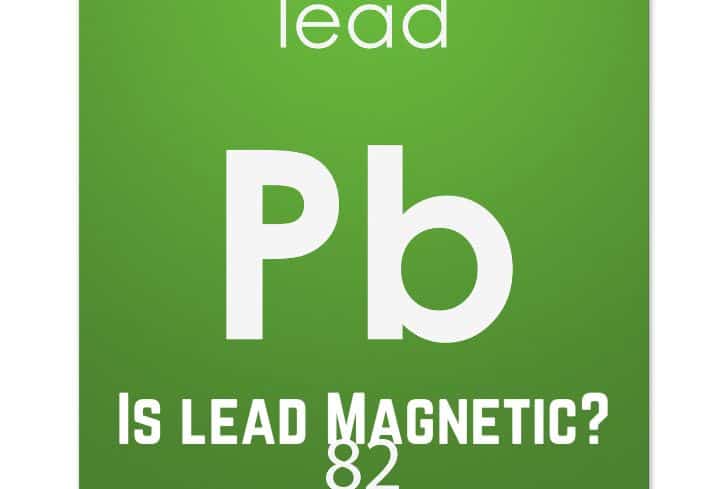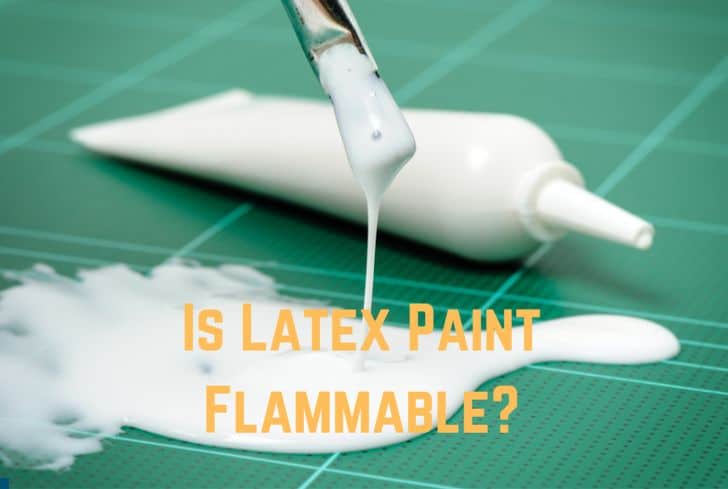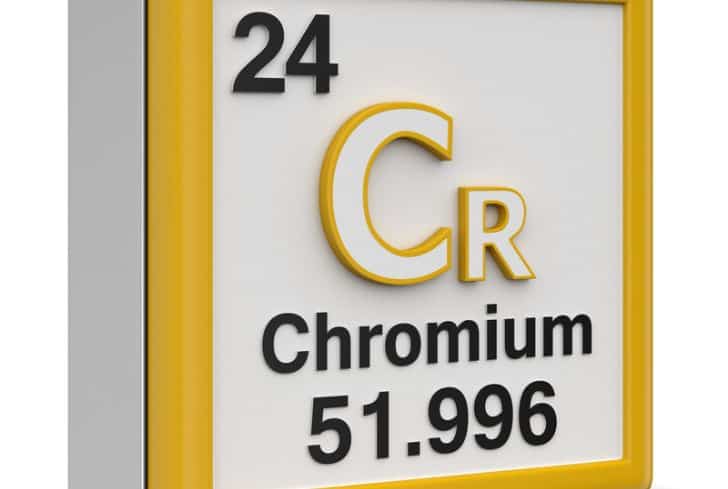Is Lead Magnetic? (No…)

Lead is a chemical element with an atomic number of 82. It is shiny grey with a tint of blue, although it turns to a dull grey color when exposed to air. Lead is a heavy metal that is denser than most common materials and has a wide range of applications from batteries to construction.
Have you ever wondered if lead is magnetic? In this article, we are going to discuss just that. We will begin with the properties and uses of lead. Then we will talk about its magnetic properties in detail, including its magnetic permeability and susceptibility. Finally, we will talk about other metals that are attracted to metals.
Read: Is Bronze Magnetic?
Is Lead Magnetic?
No, lead is not magnetic. Despite having unpaired electrons in its outer shell, lead is diamagnetic because these unpaired electrons combine to form a sigma bond within the molecular orbit. They spin in the reverse direction, therefore making lead a non-magnetic material.
Let us first try to understand what magnetism is. Magnetism is a force caused by the motion of electric charges. Every substance is made up of atoms. These atoms have electrons (particles that carry an electric charge) that circle the atom’s centre, called the nucleus.
In some substances like iron, electrons spin in the same direction. This allows their magnetic fields to combine, producing a magnetic field extending beyond the atoms. These objects are strongly attracted to magnets and are called ferromagnetic.
However, in most substances, equal numbers of electrons spin in opposite directions. This cancels out their magnetism, and they are not attracted to a magnetic field. These include things like cloth, wood, paper etc. and are called diamagnetic.
Despite having unpaired electrons, lead is diamagnetic. This is because these unpaired electrons form a sigma bond in the molecular orbit. Since all electrons are paired, their magnetism is cancelled. Therefore, lead is not attracted to magnets.
Properties and Uses of Lead
These are the properties of lead:
- Lead is a heavy metal that is denser than most materials. Because lead is quite heavy, like gold, scammers often coat a bar of lead with gold and try to sell it.
- Lead is soft and malleable, meaning that it can be hammered or pressed into shape without breaking. It is also highly ductile and inert to oxidation. Lead has a low melting point of 327°C (621 °F). This makes it ideal for soldering.
- Lead is mainly obtained from the mineral galena (found in zinc ores) by roasting. The annual production of lead is over 10 million tonnes, half of which is recycled from scrap materials, pipes, etc.
- Lead has the highest atomic number of any stable element. It is a relatively unreactive post-transition metal. It has a weak metallic character, as indicated by its amphoteric nature (ability to react with both acids and bases). Lead tends to form covalent bonds and usually exists in the +2 oxidation state. Three lead isotopes are endpoints of nuclear decay chains of heavier elements.
- In the 19th century, lead’s toxicity was widely recognized, although some Greek & Roman writers were well aware of this. Lead is a neurotoxin that accumulates in bones. It damages the nervous system, causing behavioral problems or even brain damage. This is why many old uses of lead have now been banned or replaced.
All of lead’s properties, combined with its abundance and low cost, make lead ideal for a wide range of applications:
- Because of its easy workability and resistance, lead has been used for pipes, paint, and pewter since Roman times. Even today, it is used in architecture (roofing and stained glass windows) and plumbing.
- It has also been used for pottery, hair dyes, and as an additive for petrol. However, all these uses have now been banned or replaced as lead is now known to be toxic, especially for children.
- Lead is still used in batteries, ammunition (bullets and shots), and weights (for lifting and diving).
- Pigments and white paints also use lead. Lead is also used in crystal glass and radiation shielding.
- Lead also helps to store corrosive liquids.
Lead does not have any known biological role and is toxic. The human body stores about 120 milligrams of lead in the bones.
Read: Is Carbon Steel Magnetic?
Why is Lead Diamagnetic?
Lead is diamagnetic because, although it has unpaired electrons in its outer shell, these electrons combine to form sigma bonds in the molecular orbit. They spin in the opposite direction, cancelling out their magnetism. Being diamagnetic, lead is very lightly repelled by magnets.
The electron configuration of lead is [Xe] 6s² 4f¹⁴ 5d¹⁰ 6p². This means that it has 2 unpaired electrons in its p orbital. However, these unpaired electrons pair up to form sigma bonds in the molecular orbit.
Since all the electrons are paired, the magnetic dipole of lead is aligned in the opposite direction of the applied magnetic field. Being diamagnetic, lead is very lightly repelled by magnets. This is difficult to see at room temperature with weak magnetic fields.
But at high temperatures with strong magnetic fields, lead’s diamagnetism is apparent. You can also see lead’s interaction with magnetic fields by moving a strong piece of magnet around it. Check out this video by AndyDaviesByTheSea to see how a magnet interacts with aluminum, copper, brass and lead.
He is sliding a small magnet through different materials. The magnet slows down when sliding over different metals, but slides quickly over lead. This is because of the difference in their electrical resistance.
The lower the electrical resistance (as in the case of aluminium), the higher the current. A higher current means a stronger magnetic field is produced, which is why the magnet slows down over aluminum. Lead has the highest electrical resistance, so it creates a lower current and a weak magnetic field. Therefore the magnet slides quickly down the lead.
Magnetic Susceptibility of Lead
Lead has a magnetic susceptibility of -1.8. Magnetic susceptibility is the degree to which a material can be magnetized by an applied magnetic field. The negative value indicates that lead is a diamagnetic material, which gets repelled by a magnetic field.
Magnetic susceptibility is the measure of how much a material will become magnetized in a magnetic field. It is measured as the ratio of magnetization M (magnetic moment per unit volume) to the applied magnetizing field intensity H.
If it is greater than zero ( χ > 0), it means that the material is paramagnetic and its dipoles align with the magnetic field. If it is less than zero, the material is diamagnetic and is aligned in the opposite direction.
Since lead is a diamagnetic material, it has a negative magnetic susceptibility. It will be lightly repelled by a magnetic field.
Does Lead Block Magnetic Fields?
No. Magnetic fields cannot be blocked by any metal, although they can be re-routed around materials with high permeability. Lead does not have any effect on magnetic fields because it has a magnetic permeability of 1.
Magnetic permeability is the measure of magnetization that a material obtains in response to a magnetic field. Magnetic fields always travel the path of least resistance. If a material is highly permeable, then the magnetic field lines will travel through it because they offer less resistance than the air.
A material with low magnetic permeability, like lead, will not change the route of the magnetic field lines in any way. So, lead does not block magnetic fields.
Read: Is 14k Gold Magnetic?
Is Lead a Good Conductor of Electricity?
No, lead is not a good conductor of electricity. This is because, although lead has free electrons, it reacts with atmospheric oxygen to form lead oxide, which is non-conducive.
In real-world settings, lead does not have any use as a conductor because of its electrical resistivity, ease of flow under pressure, melting point, etc. But it still has uses in electrical engineering.
Lead is used as a soldering alloy because of its low melting point, acceptable conductivity for joints, and good adhesion with other metals like copper or zinc.
What Metals Stick to a Magnet?
The magnetism of an object depends on its atomic structure. If it has unpaired electrons in its outer shell, then these will spin in the same direction, creating a strong magnetic field. In this case, the material will be strongly attracted to magnets and is called ferromagnetic.
Ferromagnetic materials are those that are capable of being magnetized. Their atoms are not aligned in their natural state but can be made to do so by applying a magnetic field. When magnetized, these become magnets themselves. Magnetic metals include:
- Iron
- Cobalt
- Nickel
Several other metals are non-magnetic. These materials do not have unpaired electrons, so the effect of their electrons’ spin is canceled out, and they are not attracted to magnets. These include aluminum, gold, lead, etc.
Conclusion
In this article, we have looked at the magnetism of lead. Although lead has unpaired electrons, these combine to form sigma bonds in the molecular orbit, effectively canceling out their magnetism. We looked at the properties and uses of lead. We also discussed its magnetic susceptibility and permeability.






